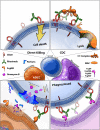Past, Present, and Future of Rituximab-The World's First Oncology Monoclonal Antibody Therapy
- PMID: 29915719
- PMCID: PMC5994406
- DOI: 10.3389/fonc.2018.00163
Past, Present, and Future of Rituximab-The World's First Oncology Monoclonal Antibody Therapy
Abstract
Rituximab is a chimeric mouse/human monoclonal antibody (mAb) therapy with binding specificity to CD20. It was the first therapeutic antibody approved for oncology patients and was the top-selling oncology drug for nearly a decade with sales reaching $8.58 billion in 2016. Since its initial approval in 1997, it has improved outcomes in all B-cell malignancies, including diffuse large B-cell lymphoma, follicular lymphoma, and chronic lymphocytic leukemia. Despite widespread use, most mechanistic data have been gathered from in vitro studies while the roles of the various response mechanisms in humans are still largely undetermined. Polymorphisms in Fc gamma receptor and complement protein genes have been implicated as potential predictors of differential response to rituximab, but have not yet shown sufficient influence to impact clinical decisions. Unlike most targeted therapies developed today, no known biomarkers to indicate target engagement/tumor response have been identified, aside from reduced tumor burden. The lack of companion biomarkers beyond CD20 itself has made it difficult to predict which patients will respond to any given anti-CD20 antibody. In the past decade, two new anti-CD20 antibodies have been approved: ofatumumab, which binds a distinct epitope of CD20, and obinutuzumab, a mAb derived from rituximab with modifications to the Fc portion and to its glycosylation. Both are fully humanized and have biological activity that is distinct from that of rituximab. In addition to these new anti-CD20 antibodies, another imminent change in targeted lymphoma treatment is the multitude of biosimilars that are becoming available as rituximab's patent expires. While the widespread use of rituximab itself will likely continue, its biosimilars will increase global access to the therapy. This review discusses current research into mechanisms and potential biomarkers of rituximab response, as well as its biosimilars and the newer CD20 binding mAb therapies. Increased ability to assess the effectiveness of rituximab in an individual patient, along with the availability of alternative anti-CD20 antibodies will likely lead to dramatic changes in how we use CD20 antibodies going forward.
Keywords: cancer; immunotherapy; lymphoma; monoclonal antibody; rituximab.
Figures





Similar articles
-
Rituximab: a review of its use in non-Hodgkin's lymphoma and chronic lymphocytic leukaemia.Drugs. 2003;63(8):803-43. doi: 10.2165/00003495-200363080-00005. Drugs. 2003. PMID: 12662126 Review.
-
New anti-CD20 monoclonal antibodies for the treatment of B-cell lymphoid malignancies.BioDrugs. 2011 Feb 1;25(1):13-25. doi: 10.2165/11539590-000000000-00000. BioDrugs. 2011. PMID: 21090841 Review.
-
Anti-CD20 treatment for B-cell malignancies: current status and future directions.Expert Opin Biol Ther. 2021 Feb;21(2):161-181. doi: 10.1080/14712598.2020.1822318. Epub 2020 Nov 9. Expert Opin Biol Ther. 2021. PMID: 32933335 Review.
-
An Evidence-based Review of Anti-CD20 Antibody-containing Regimens for the Treatment of Patients With Relapsed or Refractory Chronic Lymphocytic Leukemia, Diffuse Large B-cell Lymphoma, or Follicular Lymphoma.Clin Lymphoma Myeloma Leuk. 2018 Aug;18(8):508-518.e14. doi: 10.1016/j.clml.2018.05.009. Epub 2018 May 23. Clin Lymphoma Myeloma Leuk. 2018. PMID: 29934061 Review.
-
Complement-Regulatory Proteins CFHR1 and CFHR3 and Patient Response to Anti-CD20 Monoclonal Antibody Therapy.Clin Cancer Res. 2017 Feb 15;23(4):954-961. doi: 10.1158/1078-0432.CCR-16-1275. Epub 2016 Aug 15. Clin Cancer Res. 2017. PMID: 27528699 Free PMC article. Clinical Trial.
Cited by
-
Outcomes of Rituximab-abbs versus Rituximab in Patients with Diffuse Large B-Cell Lymphoma in a Noninferiority Study.BioDrugs. 2024 Jul;38(4):601-610. doi: 10.1007/s40259-024-00666-1. Epub 2024 Jun 27. BioDrugs. 2024. PMID: 38935234
-
Rheumatoid factor IgM autoantibodies control IgG homeostasis.Front Immunol. 2022 Oct 21;13:1016263. doi: 10.3389/fimmu.2022.1016263. eCollection 2022. Front Immunol. 2022. PMID: 36341420 Free PMC article.
-
CD19-Targeted Immunotherapies for Diffuse Large B-Cell Lymphoma.Front Immunol. 2022 Feb 24;13:837457. doi: 10.3389/fimmu.2022.837457. eCollection 2022. Front Immunol. 2022. PMID: 35280988 Free PMC article. Review.
-
Journey of CAR T‑cells: Emphasising the concepts and advancements in breast cancer (Review).Int J Oncol. 2023 Dec;63(6):130. doi: 10.3892/ijo.2023.5578. Epub 2023 Oct 13. Int J Oncol. 2023. PMID: 37830150 Free PMC article. Review.
-
Exploring novel immunotherapy biomarker candidates induced by cancer deformation.PLoS One. 2024 May 14;19(5):e0303433. doi: 10.1371/journal.pone.0303433. eCollection 2024. PLoS One. 2024. PMID: 38743676 Free PMC article.
References
-
- Nadler LM, Stashenko P, Hardy R, Kaplan WD, Button LN, Kufe DW, et al. Serotherapy of a patient with a monoclonal antibody directed against a human lymphoma-associated antigen. Cancer Res (1980) 40:3147–54. - PubMed
Publication types
Grants and funding
LinkOut - more resources
Full Text Sources
Other Literature Sources
Molecular Biology Databases
Miscellaneous

